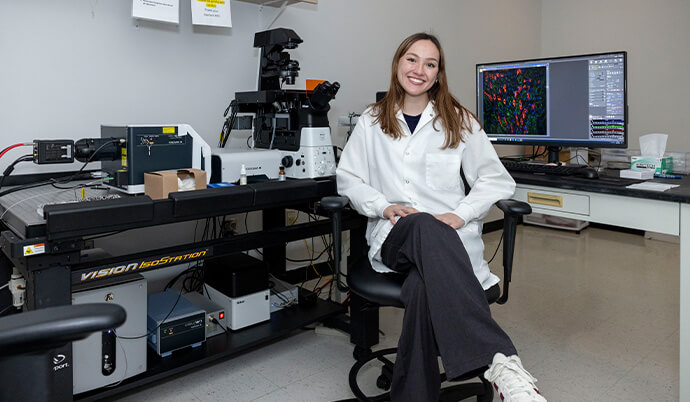Kate Lee-Gilligan – The Power of Research Immersion

When Kate Lee-Gilligan left her home state of Minnesota to attend Bates College in Lewiston, Maine, she was not sure what she wanted to study. Although she had taken an AP Biomedical Research course in high school and enjoyed the critical thinking that came with answering research questions, she considered being an English major when she got to college. Her enjoyment of Organic Chemistry led her to major in Biochemistry, but she still had not experienced true research before the SPUR program.
Attending a small, liberal arts college, Kate applied for her first research program during her junior year. Not knowing what area of research she was interested in, she was drawn to the SPUR program at Sanford Research because of the wide variety of research topics and expertise, and she was excited about the opportunity to interact with different labs. “What made Sanford stand out,” Kate said, “was it wasn’t just a summer thing. With all the workshops and meeting with the [graduate] students and really building the connections … it’s about fostering the student and making sure we have opportunities.”
In the SPUR program, Kate worked in Dr. Indra Chandrasekar’s lab, which focuses on the role of the cytoskeleton in kidney physiology and disease. Through her experience in the summer of 2025, Kate learned that she really enjoys the problem-solving aspect of science. She also gets excited about the opportunity to use “amazing technology” like the Nikon SoRa super-resolution microscope. “I get to use the SoRa three times a week, and the image quality is amazing,” Kate said with a smile. “Sometimes I look at other published work and think my images are even better!”
Through her immersive experience in the SPUR program, Kate learned what a science career is all about and how to prepare for it. She acknowledged that, prior to the program, she did not have a clear picture of the career path. “I never really even met an academic researcher,” she stated, “so it helped me understand what a career would look like and the steps I could take or the different paths that everyone goes to get themselves where they are.” She also valued the balance of guidance and independence that came with her training at Sanford Research, describing it as a “collaborative experience, not just you being told what to do, but also what you make of it.” By the end of the summer, Kate’s time in the SPUR program, with its welcoming and supportive environment, had a profound impact on shaping her interest in a science career. Her advice to other students trying to figure out their career path: “Sanford is great if you don’t know what you want to do and if you’ve never done research.”